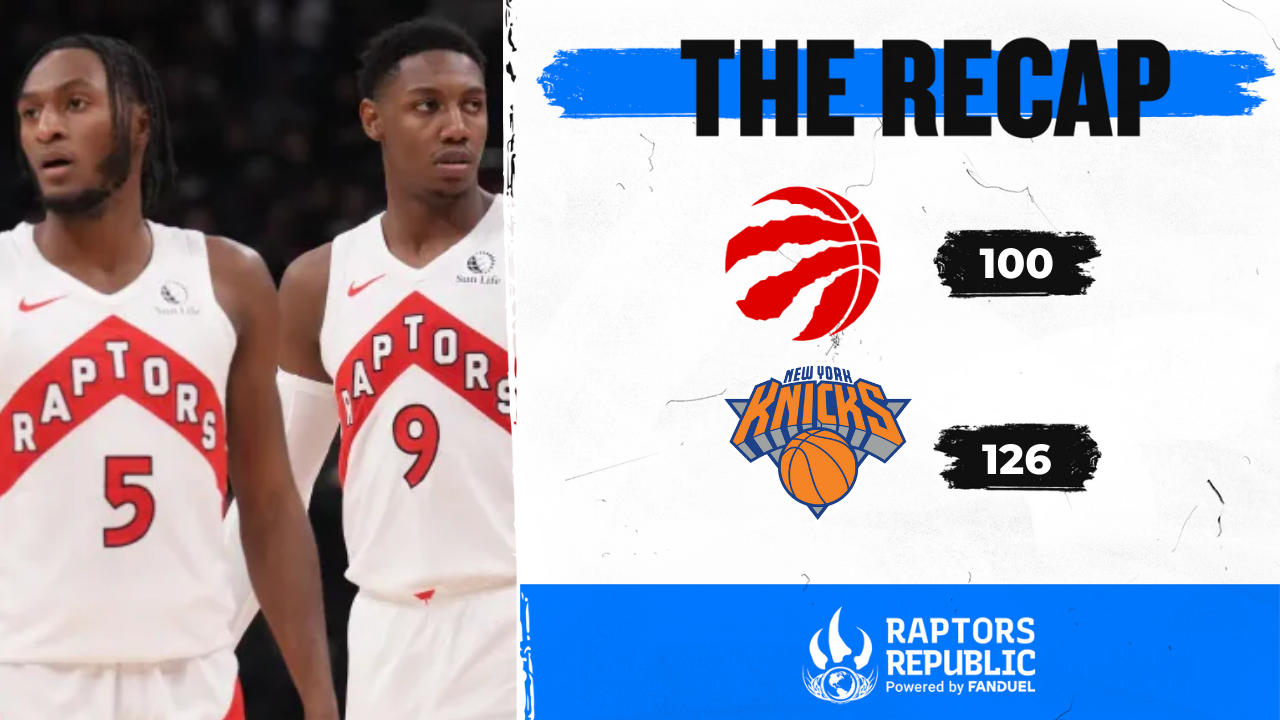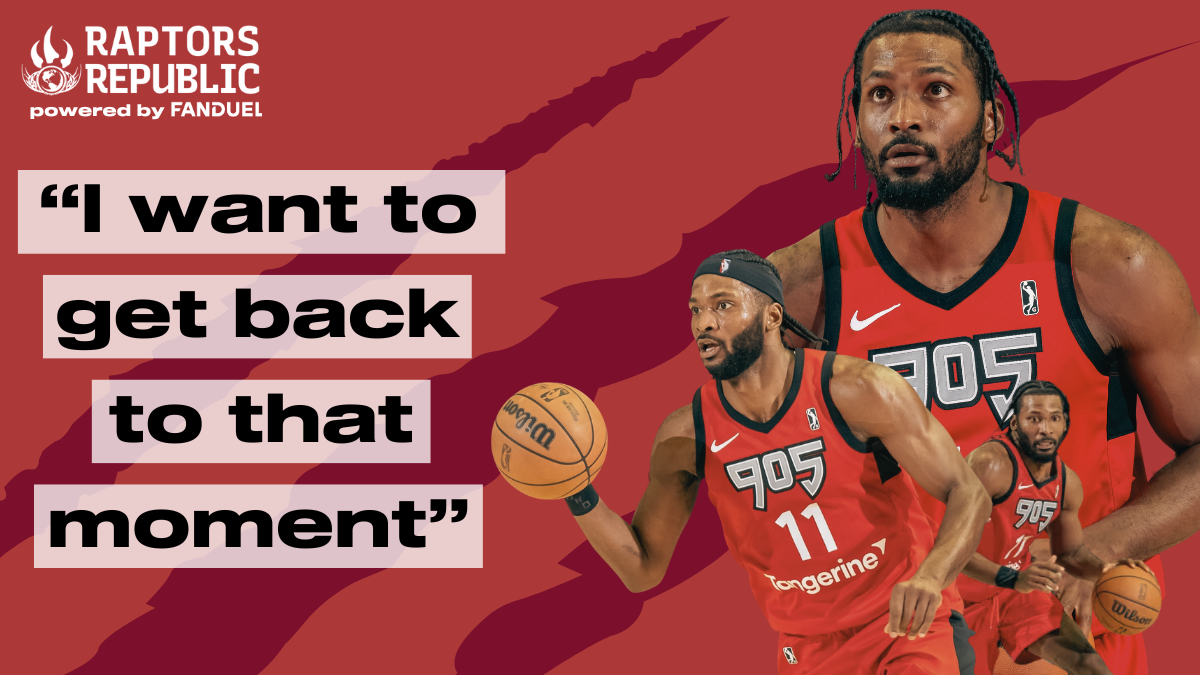Basketball is a free flowing game full of improvisational plays and interpretive reads from superstars and role players alike. Those things dictate most of what happens on a basketball court, and they’re influenced greatly by the overarching scheme, structure, and tenets that motivate some of the decision making from the players – and that comes from the coaching.
Some plays are set plays that exist under the framework, but are a little more specific. With RJ Barrett & Immanuel Quickley joining the Raptors, there’s new skillsets to work with and different wrinkles to add to plays. I’ll detail some of those wrinkles and successes that the Raptors have added and found. Strap in, and look forward to being able to identify more of the Raptors plays while you watch them live.
First up: Deki’s play.
“Opening play in the game was an ATO that Deki, my friend, I learned that play from him. That’s what he brought to the NBA, that’s what he brought to Golden State.” Darko said after the game, of his friend and Warriors assistant coach, Dejan Milojević. “I stole that play from him, and that was our opening play tonight, and we were able to score on that one. So, I dedicated this win to our team and to Deki.”
After looking at the Raptors opening play, I figured that, that wasn’t a set play. So, I clarified with Darko and he let me know that Deki’s play was their first scripted play of the game, and the shot actually came around the 10 minute mark of the first quarter. An important clarification, considering all the largest news outlets shared the story with the wrong play (including myself initially), including the Raptors themselves and the TNT broadcast the next day. So, from the mind of Dejan Milojević: an inverted ghost screen with a flare screen into an empty-side.
The Raptors have used their guards as ghost screeners for a long time — Kyle Lowry & Fred VanVleet were both fantastic at it in their time in Toronto — and Quickley represents the exact combination of quickness, awareness, and shooting ability to really make this play work. It also helps that Barnes is a tall passer so he needs less loft over the top of the flare – getting the ball to his shooter faster. Quickley hits a nice shot against a contest (that the Heat had to switch to get to), and if he wasn’t able to shoot it there, they could easily flow into an empty-side pick n’ roll. Great play design with great players.
This next one is a twist on a classic formula. The Raptors have tried to work through the post — high or low — a lot more often this season, and chose to do so to create more high-low reads to feed Pascal Siakam & Scottie Barnes.
If you’re interested in the names for these actions — you don’t have to be, if you can notice where advantages come from, without knowing names, you know ball — in the first play we are looking at the Raptors initiating through the pinch post (a flex screen initiates the pinch post action, but not included in the clips) with the Raptors setting a rip screen on the weak-side. On the second play, it’s a flex screen to pinch post initiation with that same rip screen, and a wide-pin stacked on top of it for IQ. Okay, that’s the terminology.
The first option in this play, is for the rip screen to free up RJ/Pascal cutting straight to the basket. In the first play, Anthony Davis stays at home in the paint, Taurean Prince chases over top, and so that action opens things up above-the-break for Quickley to come off the wide-pin from Schroder and comfortably walk into a triple. The main point of tension for the Lakers is are the guarding the downstream stuff or the upstream stuff. They chose the former, and exposed their weakness to the latter. Having Quickley as your shooter makes everything more dangerous here.
In the second clip we see the first option work. Since the Pacers are guarding up on the action — not keeping anyone away from it like Davis was — this means that the Raptors get an honest 2v2 in the paint with Barnes/Siakam vs. Toppin/Mathurin – who completely bungle the coverage. Mathurin calls out a switch while Toppin is chasing over top and is already in a compromised position. The result? Mathurin left the passing lane wide open, Barnes is a brutish physical presence and also very clever, so he takes Toppin’s compromised position in chase and seals him to a wide open side. Easy pass in, and a bucket.
The Raptors run this a lot, and they have a much stronger counter with Quickley in the fold.
The next two plays, focused on Quickley in particular, are an example of his interpretive play under the Raptors framework and his passive benefits to what they do.
The first one is really, really basic: Quickley is coming off of a pin-down. Now, Ja Morant isn’t top-locking or anything (the defense that a lot of teams play on Steph Curry pin-downs, for example), but he does try and beat Quickley over the top. IQ takes that defense in stride, and reroutes through the paint before flowing into a DHO, followed by a pick n’ roll. Smart and JJJ mess up the coverage, leaving IQ open, and he bangs a triple. Easy peasy, basic stuff. Basic stuff looks really good, when your players are good.
The second play is a classic in most NBA playbooks: Spain Leak. Basically, you’re expecting teams to load up to defend the Spain pick n’ roll, and you leak your shooter out of that action into open space. While Schroder runs this like a fairly straightforward pick n’ roll and hits the floater, you can see that Quickley’s gravity means that Norman Powell can’t tag Thaddeus Young – who was open on the roll. Young being open on the roll means that Kawhi Leonard has to pinch in, vacating the corner where Barnes is. Quickley’s gravity quietly opens up other avenues for his teammates, without touching the ball.
For the next one, we open with Pistol Action. The play after? Easy peasy Delay Action, and a slick back cut.
With the Raptors running Pistol, they’re trying to get Barrett and Barnes moving downhill with advantage. They also want to clear the lane of help-side defense. Remember Deki’s play? How the Heat switched that action by sending their big out to the perimeter? Well, the Raptors run a flare screen to keep Ivica Zubac out of the lane, which opens up the pass to a rolling Barnes. Run well, timed well, and a scoring play.
The second play is just a super simple delay, with a split-cut between Schroder & Barrett with Thad Young as the trigger man. Basically, I love anything the Raptors do that gets Barrett headed downhill, and with Young playing a lot of minutes lately, running delay action is a great way to get him involved. He ran lots and lots of it while in San Antonio and Chicago, and a lot of his reads are great out of it.
Hopefully you enjoyed learning some of these plays, and if you ever notice them during the game? Let me know!
Have a blessed day.



